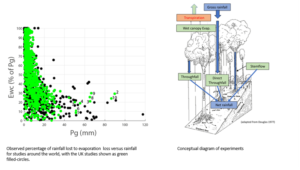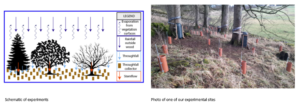Wet-canopy evaporation: Dr Trevor Page, Senior Research Associate, University of Lancaster, working on the Q-NFM project

Explaining his research, part of the Q-NFM project, on wet canopy evaporation Dr Trev Page explained: “there is a lot of interest in the potential of tree planting as a nature-based intervention to help mitigate flooding. One of the ways that trees can reduce flooding is he loss of water by evaporation from wet surfaces of vegetation directly back to the atmosphere: known as wet-canopy evaporation. A particular focus of our work is on large and extreme rainfall events that cause widespread flooding. Many previous studies concluded that evaporation from trees was insignificant for such events. But research that has measured wet-canopy ‘directly’ using forest plot experiments has often shown significant wet-canopy evaporation losses, as high as 30 % during large and extreme events. This is what we are investigating further.”
“Something that is relatively novel about our work is that we are recording high frequency meteorological conditions at the same time as we are measuring evaporation: these meteorological measurements are not reported in detail for many previous studies. What ’s more, we are looking to gather data during extreme rainfall events, as there are only relatively few data during large events. Effectively our work involves ‘storm chasing’ as we have to align the collection of our measurements with large storms. This means setting up our equipment shortly before storms are forecast and collecting the measurements as soon as possible afterwards.”

Trev described some of the challenges that Q-NFM has faced: “It isn’t easy to estimate how much evaporation may occur for a specific rainfall event as it varies hugely depending on meteorological conditions. The potential for evaporation increases when humidity is lower as the atmosphere can accept more evaporated water vapour – conversely, where the humidity is at 100% and the atmosphere is already saturated, no evaporation can take place. Where the atmosphere is not saturated and water is evaporating from the leaves, stems and trunk of the trees, the air around these surfaces becomes saturated ‘locally’ so evaporation is limited – but if windspeeds are high the local saturated air is blown away and replaced by less humid air allowing more evaporation.”
“The amount of evaporation also varies with different types of vegetation. Vegetation with a large surface area where water can sit ready to be evaporated provides higher potential for evaporation and taller vegetation is exposed to higher windspeeds, also giving higher potential for evaporation. In the UK where most large rainfall events occur in autumn and winter when deciduous trees lose their leaves reduces the potential for evaporation. For these reasons, short grass has a low potential for evaporation and tall evergreen trees provide a high potential.”
Trev described how the field research is carried out: “We are measuring rainfall outside the wood and under the tree canopy (throughfall) as well as water that reaches the ground via tree trunks (stemflow). Wet-canopy evaporation is the difference between the rainfall that falls above or outside of the canopy and that which reaches the woodland floor (throughfall and stemflow combined).”
“For accurate measurements we needed to install many throughfall collectors as throughfall is highly variable under the tree canopy.”
Looking forward to how the research may inform future land management Trev pointed out: “the advantage of using tree cover to help reduce flooding is that the water is lost to the atmosphere and does not need to be stored in the catchment during a flood event. However, losses of water by evaporation are per unit area which means that many trees have to be planted to get a significant effect for an entire catchment.”
A paper on this work is in preparation.

Contact: t.page@lancaster.ac.uk
Twitter: @NERC_QNFM
Q-NFM website: here.

